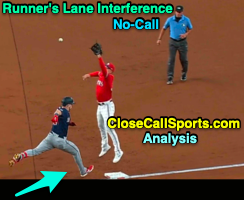The answer depends on the level of baseball being played.
Play: With one out and the bases loaded in Texas, Twins batter Ryan Jeffers hit a 1-0 curveball from Rangers pitcher Mike Foltynewicz weakly on the ground up the first base line, fielded by Folynewicz who threw high to first baseman Nate Lowe as Jeffers arrived at first base. Replays indicate Jeffers failed to run within the 45-foot runner's lane.
Video as follows:
Alternate Link: Analysis of Jeffers' RLI no-call highlights baseball rules differences (CCS)
Play: With one out and the bases loaded in Texas, Twins batter Ryan Jeffers hit a 1-0 curveball from Rangers pitcher Mike Foltynewicz weakly on the ground up the first base line, fielded by Folynewicz who threw high to first baseman Nate Lowe as Jeffers arrived at first base. Replays indicate Jeffers failed to run within the 45-foot runner's lane.
Call: 1B Umpire Cory Blaser ruled Jeffers safe at first for having beaten the throw while HP Umpire Tom Hallion no-called the potential runner's lane interference infraction.
Analysis: This is the correct call: the batter-runner is safe at first and this is not runner's lane interference. Remember, as we wrote regarding a similar play in 2016, RLI only applies to the fielder taking the throw at first base and not the fielder making the throw to first base.
In 2016, HP Umpire Dana DeMuth no-called a very similar play in New York when Astros batter Carlos Correa hit a short ground ball to Yankees pitcher Dellin Betances, who threw wildly over first baseman Mark Teixeira's head for an error. Despite argument from manager Joe Girardi, DeMuth properly stuck to his original no-call and Correa was permitted to reach base safely.
Related Post: Running Lane Interference Only Applies to Fielder at First (4/6/16).
Official Baseball Rule 5.09(a)(11) confirms this interpretation (note the added underlined/bold emphasis): "In running the last half of the distance from home base to first base, while the ball is being fielded to first base, they run outside (to the right of) the three-foot line, or inside (to the left of) the foul line, and in the umpire’s judgment in so doing interferes with the fielder taking the throw at first base, in which case the ball is dead."
Wendelstedt's interpretation is "not whether the throw is true, but whether it could still reasonably retire the runner." When a thrower (pitcher Foltynewicz in this case) makes a poor throw, it precludes consideration of RLI. Had Foltynewicz hit Jeffers in the back with his throw, then the proper call would be to declare Jeffers out for runner's lane interference by virtue of interfering with first baseman Lowe's opportunity to receive the throw. But a throw that forces the first baseman to jump, pulling him off the base as the batter-runner touches first base, does not fit the "reasonably retire" criterion.
Compare and contrast this to HP Umpire Sam Holbrook's RLI call against Nationals batter-runner Trea Turner during the 2019 World Series (that resulted in skipper Dave Martinez's ejection) in which Turner knocked the glove off Astros first baseman Yuli Gurriel's hand as Gurriel reached to catch Brad Peacock's throw to first base.
Related Post: World Series Interference - Blame the Rule, not the Umpire (10/30/19).
Important Rules Difference, College: In college, runner's lane interference can be called if a batter-runner's failure to run within the runner's lane interferes with the thrower: "If the batter-runner is running illegally to first base and his being outside the lane alters the throw of a fielder, hinders or alters a fielder’s opportunity to field the throw, or the batter-runner is hit by the throw that has been made in an attempt to make a play, it shall be called interference and the batter-runner is to be called out" (NCAA 7-11-p AR 1).
Another Different Rule, High School: The National Federation takes it a step further: It doesn't matter whether or not the umpire judges that interference with the throw or catch occurred. NFHS Rule 8-4-1g states a batter-runner is out simply by running outside the three-foot running lane while the ball is being fielded or thrown to first base.
As NFHS Rule 8-4-1g.2 states, "the batter runner is considered outside the running lane lines if either foot is outside either line."
Video as follows:
Alternate Link: Analysis of Jeffers' RLI no-call highlights baseball rules differences (CCS)


